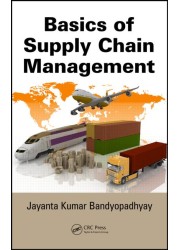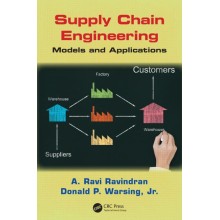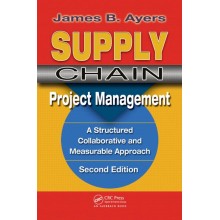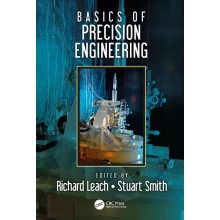Basics of Supply Chain Management
ISBN: 9781466588929
Author: Jayanta Kumar Bandyopadhyay
Dispatch Time: 15 - 30 Days
Quantity:
-
Add to Compare
Features
-
- Covers all modules of a basic supply chain management course
- Contains sections on issues of particular contemporary importance such as global alliances and outsourcing
- Includes discussion questions after every chapter
- Presents case studies of 20 different companies to illustrate different supply chain strategies and issues
- Includes many self-study test questions to help you prepare for the certification exam
Summary
The practice of supply chain management has become widespread in most industries. It is now included in the curriculum of many business schools in the United States and in many countries around the world. A number of professional associations, such as the American Production and Inventory Control Society and the Supply Chain Management Society, offer certification programs in supply chain management for practicing professionals. This book covers the contents of the basic supply chain management course and helps you prepare for the certification examination in supply chain management.
Basics of Supply Chain Management covers all modules of a core supply chain management course, including:
- Transformation process
- Forecasting and managing demand
- Planning and production scheduling
- Inventory management
- Purchasing management
- Distribution management
- Global supply chain issues
Authored by a practitioner with the highest level of industrial experience and recognition, this book presents each concept fully and in an accessible manner. To aid understanding, it includes many practice problems, self-study test questions, and case studies. The case studies of 20 different companies can be used to teach graduate courses in supply chain management using the case method.
National as well as global demand for supply chain management experts has been growing exponentially. Therefore, learning supply chain management can lead to a very rewarding professional career path. This book gives you the information you need to get started on that path.
Table of Contents
Introduction
Introduction
Elements of Supply Chain
Operating Environment of Supply Chain
Manufacturing Planning and Control System
Planning Hierarchy in a Manufacturing Planning and Control System
Capacity Management
Computerized Manufacturing Resource Planning System
Enterprise Resource Planning Systems
Distribution Planning Systems
Basic Production Planning Strategies
Transformation of Demand into Supply: Designing Products to Meet Customer Expectations
Introduction
Designing Products to Meet Customer Needs and Expectations
Product Design Determines Product Quality
Total Quality Management and Product Design
Quality Function Deployment and Product Design
Taguchi’s Methodology for Product Design
Product Design Strategies
Distinctive Competence and Product Design
Order-Winning Criteria and Order Qualifiers and Product Design
Transformation Process Choices for Making Products Conforming to Product Design Specifications and Tolerances
Introduction
Traditional Manufacturing Process Choices
Just-in-Time Manufacturing
Objectives of the JIT Approach to Manufacturing
The Key Elements of the JIT Concept
Principles of JIT Manufacturing
Manufacturing Process Design for JIT Production
Characteristics of a JIT Environment
Supplier Relations in JIT Environment
Employee Involvement and Empowerment in JIT Environment
Effects of JIT on Manufacturing Planning and Control System
Effects of JIT on Production Planning
Effects of JIT on Master Production Scheduling
Effects of JIT on Material Requirements Planning
Effects of JIT on Capacity Management
Effects of JIT on Inventory Management
Effects of JIT on Organization Design
Effects of JIT on Job Design
Total Quality Management and JIT
Benchmarking
Taguchi’s Methodology for Quality Product Design
Mistake Proofing and Automatic On-Line Inspection
Statistical Concepts for Quality Management
Statistical Quality Control Charts
Process Capability Analysis
Demand Forecasting and Demand Management
Introduction
Understanding Target Customers
Demand Management
Demand Forecasting
Principles of Forecasting Demand
Collection and Preparation of Data for Forecasting
Forecasting Methods
Some Quantitative Forecasting Techniques for Forecasting Short-Range Demand
Forecasting Seasonal Demand
Forecasting Long-Range Trend
Tracking the Forecast for Error
Master Planning
Introduction
Manufacturing Planning and Control System
Priority and Capacity
Planning Hierarchy
Computerized Manufacturing Planning and Control System
Production Planning Strategies
Basic Production Planning Strategies
Developing a Production Plan
Resource Requirements Planning
Master Production Scheduling
Introduction
Master Production Schedule
Preparing a Master Production Schedule
Master Scheduling Decisions
MPS and Delivery Promises
Planning Horizon for an MPS
Time Fences
Summary and Conclusion
Material Requirements Planning
Introduction
Material Requirements Planning
Objectives of MRP
MRP System
Inputs to the MRP System
Capacity Planning
Available Capacity
Work Center Utilization Rate
Work Center Efficiency
Work Center Rated Capacity
Work Center Demonstrated Capacity
Work Center Required Capacity
Inputs to Capacity Requirements Planning
Shop Calendar
Scheduling Orders
Load Profile
Production and Purchasing Activity Control
Planning Activities
PAC in Different Types of Manufacturing Systems
Data Requirements for Processing PAC
Order Preparation
Scheduling
Manufacturing Lead Time
Scheduling Techniques
Inventory Management
Introduction
Aggregate Inventory Management
Physical Classification of Inventory
Supply and Demand Patterns of Inventory
Functions of Inventories in Batch Production Systems
Objectives of Inventory Management
Inventory Costs
ABC Inventory Control
Inventory Ordering System Models
Basic Economic Order Quantity Model
Purchasing Management
Introduction
Purchasing Management
Purchasing Cycle
Developing Specification
Selecting Suppliers
Supplier Development
Supplier Relationship Management
Physical Distribution Management
Introduction
Physical Supply Management
Physical Distribution Management
An Integrated Physical Distribution System
Modes of Transportation
Types of Carriers
Concept of Total System Cost
Example Problems
Distribution Inventory Management
Introduction
Distribution Inventories
Distribution Inventory Management Systems
Warehousing
Material Handling in a Warehouse
Multi-warehouse System
Cost Characteristics in Multi-warehouse System
Total Cost Curve of a Multi-warehouse System
Global and Other Issues in SCM
Introduction
Total Quality Management in the Global Supply Chain
Respecting Human Resources and Human Rights in the Global Supply Chain
Suppliers Relationship Management in the Global Supply Chain
Customer Relationship Management in the Global Supply Chain
Appendix A: Cases in Supply Chain Management
Appendix B: Self-Study Practice Questions for Basic Supply Chain Management
Write a review
Your Name:Your Review: Note: HTML is not translated!
Rating: Bad Good
Enter the code in the box below:
Copyright © 2014 Engineering Standards Bureau. All Rights Reserved.
Developed By Zoom Into Web








